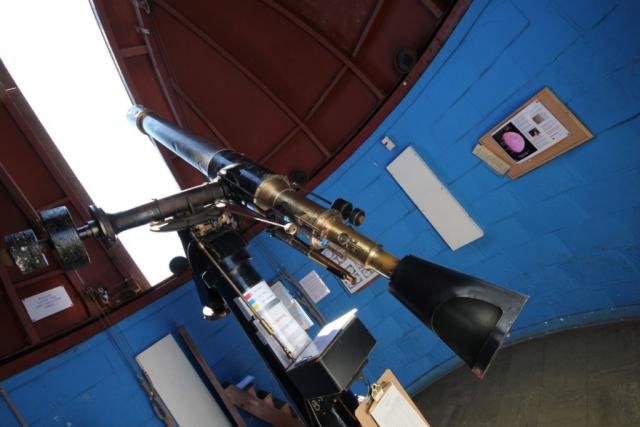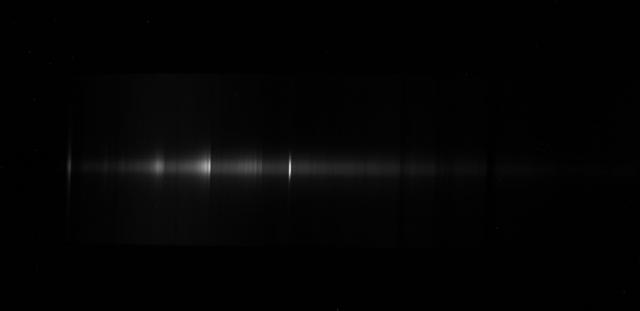Forum Replies Created
-
AuthorPosts
-
 David StrangeParticipant
David StrangeParticipantAt around the time Lowell’s “Canals on Mars” story was evolving, H.G,Wells was studying biology at the Normal School of Science, apparently he attended a few of Lockyer’s astronomy lectures which no doubt seeded his ideas for “War of the Worlds”.
David
 David StrangeParticipant
David StrangeParticipantWay back in 1963 the late Donald Barber the last professional astronomer at NLO believed there was life in the Venusian atmosphere. By his observations of bacterial growth on his photographic plates which coincided with inferior conjunctions of Venus he deduced these organisms had been blown to us by the solar wind. He even sent the bacteria away for analysis, which were unable to be identified! Article here:
http://shadetreephysics.com/Barber%201963.htm
David
 David StrangeParticipant
David StrangeParticipantHello Ed,
Here at the Norman Lockyer Observatory we have a wifi signal that reaches our domes and the surrounding grounds outside. Folks with telescopes set up as well as those imaging from the telescopes in the observatory can transmit their videos/ccd images to our lecture theatre projector via Radmin, Anydesk or Teamviewer, so people can watch in the warm! Sadly, not at the moment because of Covid, but we can still broadcast via Zoom.
David
 David StrangeParticipant
David StrangeParticipantHi David,
No freeserve is now defunct. I’ve pm’d you my contact details.
David
 David StrangeParticipant
David StrangeParticipantDavid, we can offer to live stream from the Lockyer telescope (6.25″) – the one that Lockyer used to discover Helium on the Sun. We have a good broadband connection at NLO.
David

 David StrangeParticipant
David StrangeParticipantThanks Hazel, cloudy here for the next few days as well.
David
 David StrangeParticipant
David StrangeParticipantCompiled from images using 28mm – 300mm lens, 100mm f/6 refractor, 50cm f/4 newtonian from Salcombe Regis & NLO, Sidmouth.
https://www.youtube.com/watch?v=Q35MKbjnWZM
David
 David StrangeParticipant
David StrangeParticipantNorman Lockyer Observatory members gather for the first time since lockdown for a news bulletin on Comet Neowise for ITV’s News at Ten.
https://m.youtube.com/watch?v=2ciG0yTR6Q4
David
 David StrangeParticipant
David StrangeParticipantThis is a comparison of raw spectra taken 8 days apart showing depletion of sodium emission but increase in C2 and CN.The comet looks like it has now lost its golden colour and images are picking up more blue/green in the coma perhaps due to this increase?
David
 David StrangeParticipant
David StrangeParticipantClear here again tonight! Also just realised that my Canon has been imaging at f/27! Wondered why I wasn’t getting the ion tail recorded, hope to do better now!
David
 David StrangeParticipant
David StrangeParticipantComet Neowise caught in single 20s exp. with Ricoh Theta camera last night
https://theta360.com/s/jOGdKcj6M9KsLhWHUK5I5aqwq?utm_source=app_theta_twitter&utm_medium=social
David
 David StrangeParticipant
David StrangeParticipantThanks Robin, I thought that was probably the case! So a Sodium tail is back in the running!
Have you got a spectra across the tail yet?
David
 David StrangeParticipant
David StrangeParticipantHere’s a great image and spectrum by Torsten Hansen using a star analyser and 135mm lens. The sodium tail is much straighter than the dust tail, so would definitely manifest itself towards the left. See lower image here:
 David StrangeParticipant
David StrangeParticipantThanks for that link Robin. It looks as though the offset of the Sodium tail is just 3 degrees from that of the main dust tail in the PSI image. Presuming that this image shows south at the top, the Sodium image is offset in a clockwise direction. I have measured Andy’s image and it shows that the red tail is offset approx 17 degrees in an anti-clockwise direction. So I don’t think the red tail is Sodium.
David
 David StrangeParticipant
David StrangeParticipantThat’s interesting, the colour of this certainly looks redder than sodium. But I don’t see much evidence of NH2 in the Neowise spectrum, but I guess most spectra have been centred on the nuclear region.
David
 David StrangeParticipant
David StrangeParticipantBeautiful image! I’m guessing it could be due to Na emission in the yellow?
https://britastro.org/node/23206
David
 David StrangeParticipant
David StrangeParticipant Caught this spectrum of the comet this morning showing bright Sodium line, C2 banding and I’m guessing CN emission on far left? 20 x30s with ASI 183mm and Alpy (binned 2×2 at 2.5A/pixel).Taken with 50cm f/4 Connaught Dome at NLO.
Caught this spectrum of the comet this morning showing bright Sodium line, C2 banding and I’m guessing CN emission on far left? 20 x30s with ASI 183mm and Alpy (binned 2×2 at 2.5A/pixel).Taken with 50cm f/4 Connaught Dome at NLO.David
 David StrangeParticipant
David StrangeParticipantSorry, cloudy here in Devon. Could only catch a fleeting glance of Capella every now and again.
David
 David StrangeParticipant
David StrangeParticipantGreat shot! Yes, definitely there.
David
 David StrangeParticipant
David StrangeParticipantThanks for that. i am researching Lockyer’s work on sunspots when he projected the sun’s image on to a screen with a slit in it, over which he positioned a sunspot. With his spectroscope receiving the light of the spot, (I guess it was his 7 prism one) he noticed that the spectral lines were widened. This was years before Pieter Zeeman’s discovery of the splitting of spectral lines due to magnetism and Hale’s observations linking sunspots and magnetism.
David
-
AuthorPosts
